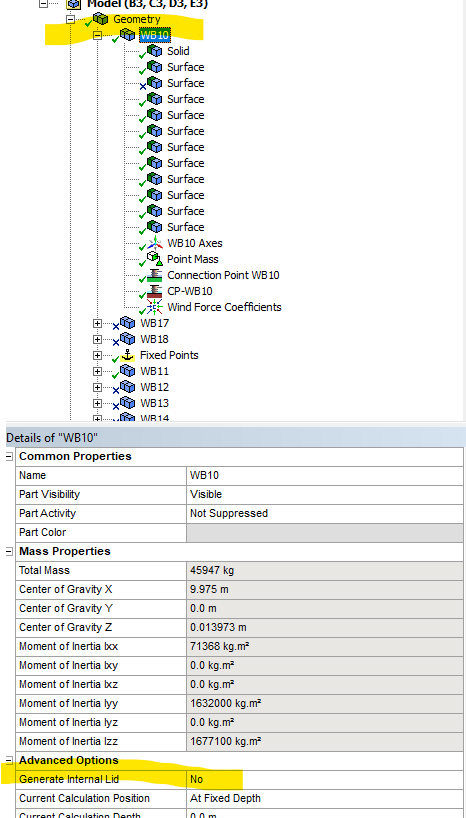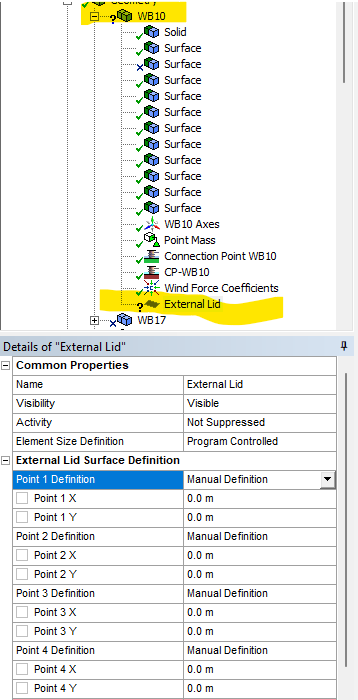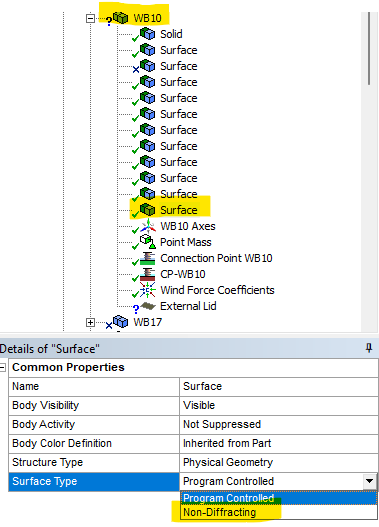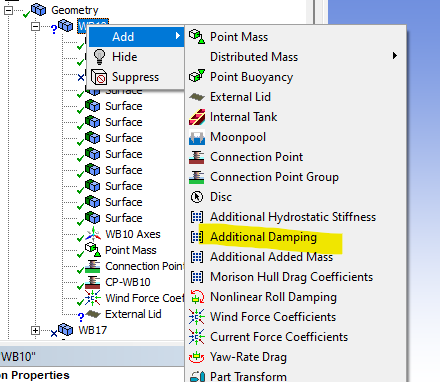TAGGED: ansys-aqwa, ansysaqwa, aqwa, aqwa-errors
-
-
April 11, 2025 at 11:44 am
M. Namaki
SubscriberDear َANSYS community,
I'm currently working on a simulation in ANSYS AQWA (2023 R2) and have encountered two persistent issues that I’d like to better understand and resolve.
1. CONVOLUTION WARNING – Inaccurate Convolution Fit
I receive repeated warnings such as:
"CONVOLUTION WARNING. An inaccurate convolution fit has been detected to the added mass/damping for structure #X/Y Surge(X)/Pitch(Y) for frequency #50. The fit quality was ~30% (or sometimes even more). This can be caused by insufficient frequencies or an unusual geometry of the structure. PLEASE - ENSURE THAT THERE ARE SUFFICIENT FREQUENCIES BEFORE contacting user support. Frequency range should be at least 0.077 to 2.603 rad/sec."
I’ve noticed that when I change the frequency range in the Hydrodynamic Diffraction module to fall within the recommended bounds (e.g., 0.077 to 2.603 rad/s), this warning doesn't disappear. However, I’m looking for a way to first understand where does this problem's roots come from and to eliminate or minimize this warning (even without changing the frequency range if it's possible, by modifying input parameters instead). Could anyone advise what model settings or inputs can be adjusted to improve the convolution fit quality?
2. "JACOBI: Failed to Converge" Warning
Additionally, I receive the warning:
"JACOBI: Failed to Converge."
This appears during the simulation, but the documentation does not provide much context. I would appreciate any insight into what causes this issue and how to resolve it.
I need to add that the simulation involves multiple hydrodynamically interacting structures. the project completes successfully despite the warnings, but I would prefer to clean up these issues for better accuracy.
Any advice or suggestions from experienced users would be greatly appreciated.
-
April 15, 2025 at 1:02 pm
Shuangxing Du
Ansys EmployeeFrom the above messages, it seems that the qualities of the calculated damping matrices for the hydrodynamic interaction strucures are not good enough.
I wonder if you had applied the external lids for suppressing the natural frequency effect of the restricted fluid between structures (see 4.2.2. Suspending Standing Waves) and the internal lids for removing the irregular frequency effect (see 4.1.3. Removal of Irregular Frequencies) in the Hydrodynamic Diffraction analysis. If the distances of the surfaces of the structures between the structure-structure gaps are very small, please set such surfaces to be non-diffracting surface.
Once you have had above mentioned treatments, please plot the damping coefficients against frequency to see if the curves are more smooth than before.
-
April 21, 2025 at 11:01 am
M. Namaki
SubscriberHi, thank you very much for your helpful response!
I’ve read the sections you mentioned about external and internal lids (4.1.3 and 4.2.2), but I’m still not quite sure how to apply these solutions in practice within ANSYS AQWA. I’d appreciate it if you could kindly clarify a few points:
Where exactly should I define the external or internal lids in the model? Should I modify something in the Tree Outline or in the mesh/panel definitions?
If I need to mark certain panels (e.g., gap surfaces) as non-diffracting, how do I do that in AQWA Workbench or in the pre-processor? I couldn’t find any option to assign that directly. Could you please guide me through the steps?
In my model, the minimum distance between structures is about 2 meters. Is that still considered small enough to cause the irregular frequency warning?
You mentioned checking the damping coefficients vs frequency — where can I find or plot those in AQWA?
Finally, is there any parameter like a damping factor I can change manually to improve the matrix quality, and where can I find it?
Any extra clarification or a simple example would be incredibly helpful. Thanks again for your time and support!
-
-
April 22, 2025 at 9:45 am
Shuangxing Du
Ansys Employee(1) Internal lid can be automatically defined for each part by set "Generate Internal Lid" as Yes.
From Ansys version 2024 R1, you can directly define the external lid from Aqwa Editor associated to a part,
(2) You can set surfaces of a part to be Non-Diffracting
(3) It depends on how large your model is.
(4) From Hydrodynamic Diffraction analysis -> Solution -> Insert Result -> Radiation Coefficients -> Radiation Damping, you could plot it.
(5) You can define additional damping matrix
-
April 25, 2025 at 2:25 pm
M. Namaki
SubscriberThanks for your help.
but I have ansys 2023 R2. how to define the external lid from Aqwa Editor in this version?
the bodies are not non-diffracting so I think setting the surfaces to be Non-Diffracting won't help. and I would appreciate if you could explain how the additional damping could help me because I'm afraid it might change the whole topic I am working on? -
April 25, 2025 at 2:47 pm
Shuangxing Du
Ansys EmployeeA body is not non-diffracting, but it may consist of several external surfaces, you can just set the surface facing the gap to be non-diffracting.
In Geometry, you can define a surface on the mean water level, between the gap of the structutres and let its normal pointing upwards, and move this surface in the component of a structure.
In Aqwa Editor, you can set this surface as the external Lid.
In your previous question (5), you asked "Finally, is there any parameter like a damping factor I can change manually to improve the matrix quality, and where can I find it?", I replied that you could define the additional damping matrix in Aqwa Editor. I have no comment on how the additional damping could help.
-
May 3, 2025 at 4:59 pm
M. Namaki
SubscriberHi again, and thank you for your previous advice — it helped me resolve the convolution warning by defining the external lid as suggested.
However, I’m still seeing the following issues:
JACOBI: Failed to Converge — This error still appears, and I’m not sure how to fix it. Do you have any guidance on what causes this convergence issue in AQWA and how I might resolve it?
Negative generalized damping warnings — The solver reports multiple negative damping values at specific frequencies like 3.54 rad/s or 3.67 rad/s, but these frequencies are not even part of the frequency range I defined in my diffraction analysis. Why is AQWA checking or reporting damping at these out-of-range frequencies?
External Lid Gap Warning — A message says:
“An External Lid Gap of less than 0.30808 m will be overridden... Expect warnings while solving.”
My gap is around 2 meters, so I’m confused about this message. Where exactly does AQWA measure this gap? And how can I avoid the warning if I already have sufficient spacing between structures?
I would really appreciate any explanation of why these issues occur and what practical steps I can take in the model (Tree Outline, meshing, solver setup, etc.) to address them.
Thanks once again for your continued support and guidance!
-
-
- You must be logged in to reply to this topic.



-
4673
-
1565
-
1386
-
1231
-
1021

© 2025 Copyright ANSYS, Inc. All rights reserved.













